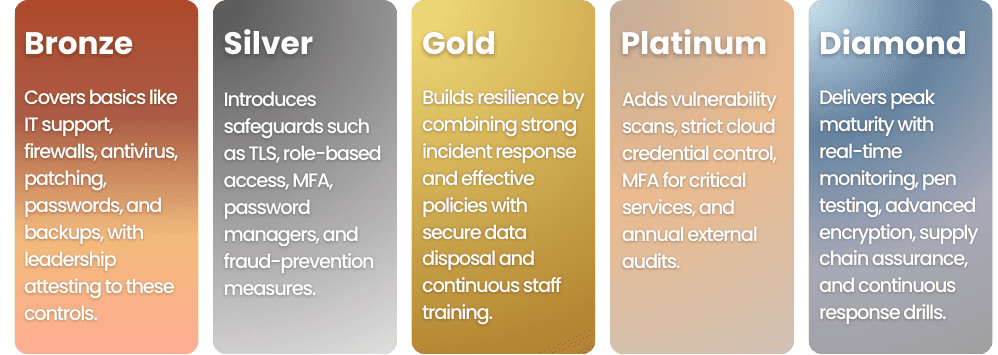Build Cyber Resilience with SMB1001
Table of Content
Overview
Cybersecurity has become one of the defining challenges for organisations of every size, but for small and medium businesses (SMBs) the challenge is particularly sharp. Limited budgets, lean IT teams, and competing priorities often make it difficult for SMBs to implement the kind of security frameworks that larger enterprises take for granted. At the same time, threat actors are increasingly targeting smaller organisations, knowing that a single weak control can open the door to disruption or data theft.
In response to this growing gap, the SMB1001:2025 cybersecurity standard was introduced as a dedicated framework designed specifically for small and medium-sized businesses. Released in September 2024, it offers a tiered approach that balances effectiveness with accessibility, ensuring that critical controls are within reach even for resource-constrained organisations.
What makes SMB1001 different?
Unlike traditional enterprise security standards, which can be prohibitively complex and expensive to implement, the SMB1001 framework focuses on practical and scalable measures. It is built to reflect the unique realities of smaller organisations, where every investment must demonstrate measurable impact.
The framework aligns with internationally recognised models such as the Australian Essential Eight, and UK Cyber Essentials. By drawing from these established frameworks, SMB1001 ensures that businesses adopting it are not only protecting themselves locally but also meeting expectations recognised across global markets.
Why SMB1001 matters for Small Businesses?
Cyber incidents involving SMBs are becoming alarmingly frequent. According to recent reports, small businesses now account for a significant proportion of ransomware and phishing victims worldwide. Attackers increasingly view SMBs as “soft targets”, often lacking the resources for advanced monitoring or dedicated security staff.
The SMB1001 framework helps close this vulnerability gap. It provides a roadmap that allows smaller organisations to build cyber resilience incrementally, without overextending resources. Certification under the standard also signals to partners, regulators, and customers that the organisation is serious about protecting sensitive data and business continuity.
The Tiered levels of SMB1001
One of the most notable features of the framework is its five-tier maturity model, beginning with basic protections and extending to advanced, real-time cybersecurity practices. Each tier represents a step forward in terms of both technical controls and organisational accountability.

Each step in this model is not just technical; it requires accountability from directors and executives, ensuring cybersecurity is embedded into governance, not treated as a back-office task.
The five core pillars of SMB1001
Beneath the tiered structure, the framework is organised around five central pillars that address the core components of digital resilience:
1. Technology Management
Managing infrastructure remains the backbone of security. This includes securing hardware, software, and networks with modern controls such as firewalls, endpoint protection, and intrusion detection. Regular updates and patch cycles reduce vulnerabilities before they can be exploited.
2. Access Management
Restricting access is critical. Strong authentication mechanisms like multi-factor authentication (MFA) and unique user accounts ensure that only authorised individuals interact with sensitive systems. Periodic reviews prevent unnecessary or outdated access privileges from persisting.
3. Backup and Recovery
Business continuity depends on effective recovery strategies. The framework mandates robust backup procedures and tested recovery plans to reduce downtime and data loss in the event of ransomware or other incidents.
4. Policies and Processes
Security must be codified through clear policies and operating procedures. This includes incident response planning, acceptable use guidelines, and data protection practices. Documented processes create consistency and reduce reliance on individual staff knowledge.
5. Education and Training
Employees remain one of the most important layers of defence. By empowering staff with practical cybersecurity knowledge from recognising phishing emails to handling sensitive data the framework helps to instil a culture of vigilance across all levels of the business.
Business value beyond compliance
Adopting SMB1001 goes beyond compliance checklists. For many organisations, certification becomes a differentiator in the market, especially when bidding for contracts where security is a selection criterion. It enhances customer confidence, strengthens partner relationships, and provides a stepping stone towards advanced standards like ISO/IEC 27001.
In a competitive business environment, demonstrating strong cybersecurity practices is not just about risk reduction; it is about credibility and trust.
Closing thought
The SMB1001 standard reflects a recognition that small and medium-sized businesses are no longer peripheral players in the digital economy; they are central to it, and as such, they are prime targets for cyberattacks. By tailoring cybersecurity to the specific needs of SMBs, the framework provides both a practical entry point and a pathway to maturity.
At its core, SMB1001 empowers SMBs to move from reactive defence to proactive resilience, ensuring that size is no longer a barrier to robust cybersecurity.
